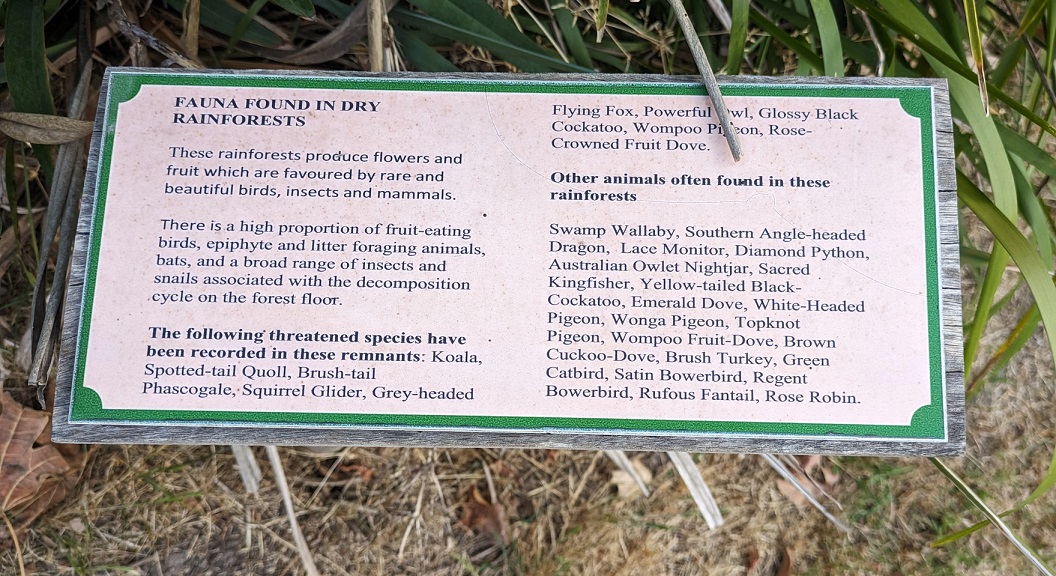Interview with christine pike
by Robyn Werkhoven – from arts zine March 2023
A mural is any piece of graphic artwork that is painted or applied directly to a wall, ceiling or other permanent substrate. Mural techniques include fresco, mosaic, graffiti and marouflage.

Tell me about the mural commission for the Arboretum (Botanical Garden) in East Gresford, NSW.
The team behind the Gresford Arboretum had a vision to include art, both murals and sculpture, in the botanical garden. I was delighted to be commissioned to paint a mural and be part of what the Gresford District Community Group is creating for the town, in conjunction with Gresford District Landcare Group and an enthusiastic team of volunteers. I was given a large list of plants and animals associated with dry rainforest species with a special interest in flora as a food source.

Where did you find the inspiration for this mural?
The Arboretum itself provided me inspiration. Even in its early stages, it is impressive. The planting and layout alone is an art form. I wanted to include what was in the Arboretum and spent two years studying the changes in plants. The changes in the Lace Bark Tree were spectacular to witness.

What preliminary work was needed before starting to paint the mural, eg: study of wildlife and drawing?
I did quite a bit of preliminary work before I started painting. While murals haven’t been a part of my personal art practice, I’ve taught mural painting to school children and was very conscious of the importance of plenty of study before putting paint on the panels. It was COVID time though so I was unable to visit a zoo or museum to study live. Fortunately, I had lots of local help. Thanks to neighbours and local bird lovers, I gained so much knowledge of (and love and respect for!) our local wildlife. It wasn’t unusual for my neighbours to see me outside at daybreak, still in pyjamas, trying to catch footage of black cockatoos. Local photographers also helped me, sharing fantastic images of The Powerful Owl, Wedge Tail Eagle and Satin Bower Birds and more, and they gave me artistic license to make changes in the mural.
Online and library research also helped, particularly at the beginning, in understanding, for example, how big in comparison are the male/female or one species to another.
Once I was allowed to travel in my district (Dungog Shire), by which time the mural was underway, I did a 32 kilometre hike in the Barrington National Park.
The hard part was landing which of the many species I would paint. Eventually I landed on four groupings: 1. Cockatoos, 2. King Parrots/Satin Bower Birds, 3. Nocturnal powerful owl, Possum, & Phascogale, 4. Wedgetail eagle & chick. I did mud maps of compositions on paper then transferred them to a program on my iPad called Procreate which was a real time saver as I went back and forth with different combinations.

It is a large 4 panelled work, how long did the project take?
The project took about 2 years, and I think I would have kept refining had it not been for a dead line date. Studying and planning/design took a long time, and Covid put a huge hold on the commission mainly due to travel restrictions. Once that final protective coating goes on there’s no going back.
What paint do you use for outdoor murals and final lacquer for future preservation?
I used Aluminium Composite Panels, four of them each 1.5 x 2 metres. I sanded them, then rolled the primer Haymes Ultracover over them. I used Haymes, Solashield low sheen. Some colours where translucent and needed several coats to achieve the required intensity, especially the red. I used a final coat of Haymes Ultimate Exterior & Anti-Graffiti Coating in Saturn for protection. I used three coats and found it easier to apply horizontal using the air conditioner in the studio due to high humidity and time restraints. I used mainly exterior paint brushes from the hardware shop and rollers for parts of the backgrounds.
I was glad to have a large enough studio to work on all four at home. I moved from one to another, waiting for the paint to dry.

Interview by Robyn Werkhoven and originally published in Arts Zine March 2023 ARTS ZINE MARCH 2023 by Robyn Werkhoven – Issuu
